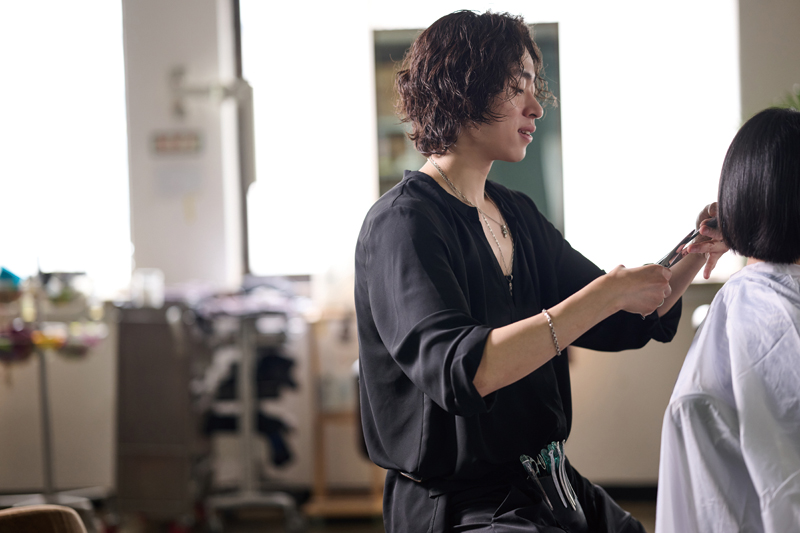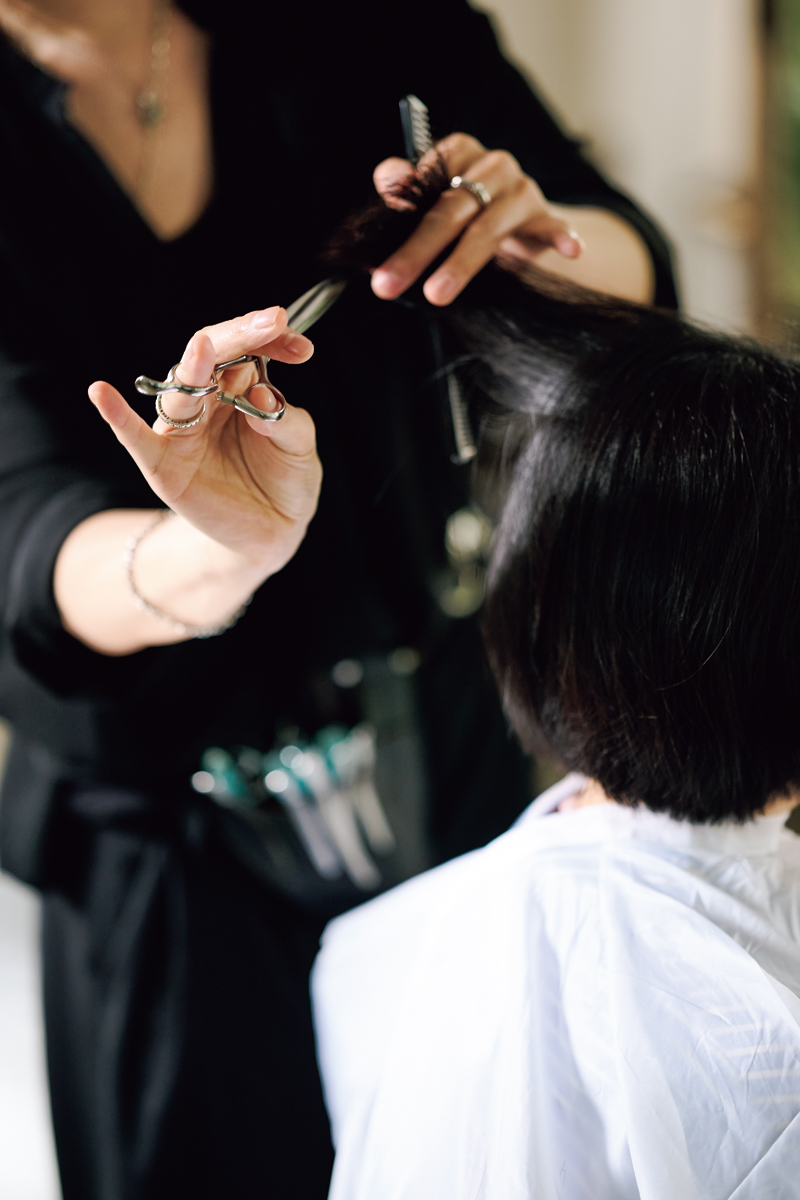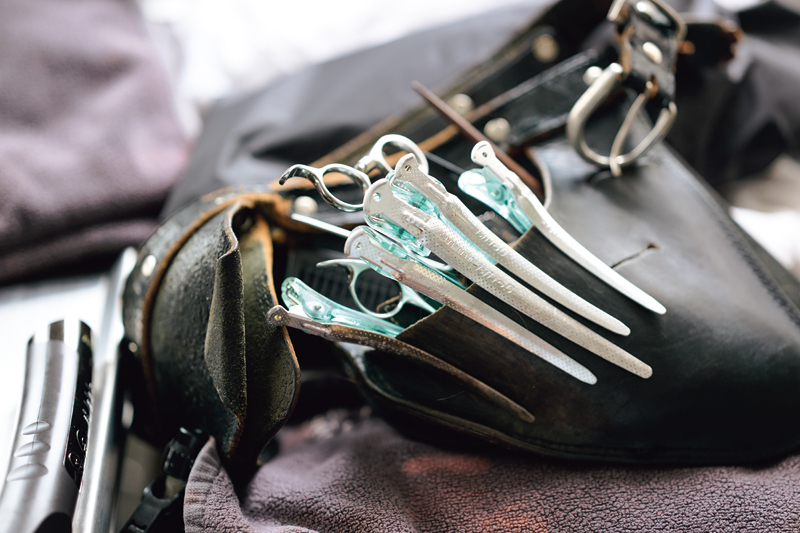To Nakayashiki Kenta, being a hairdresser is about close communication with all kinds of people. The Japanese hair designer has been working in Korea for more than six years and hopes to stay and grow old alongside his friends and customers.

Nakayashiki Kenta has customers of all ages — predominantly women — but only accepts a small number each day, giving them his undivided attention.
At Nakayashiki Kenta’s salon, everyone feels special because he only books one client at a time, two at most unless a family comes together. As he washes, snips, dries, and styles, customers can enjoy the views of the changing seasons in the nearby park. It’s a small luxury offered by this shop surrounded by towering buildings and sets the mood for a relaxing, heart-to-heart chat. That is exactly what Nakayashiki hopes to achieve.
“Being a hairstylist allows me to meet people and get to know them better. I want to maintain good relationships with nice people rather than make a lot of money running my salon,” he says.
NEED FOR CHANGE
Before moving to Korea, Nakayashiki worked at a very popular hair salon in Omotesandō, a leafy upscale neighborhood in Tokyo that boasts luxury shopping and popular restaurants. He was so busy that he sometimes tended to fourteen customers in one hour. Amid the constant, overwhelming flow, he couldn’t remember their faces, let alone their names. It left Kenta unhappy and frustrated, as he had become a hairstylist expecting to get acquainted with different people and expand his horizons.
“I worked from early morning until late at night, rarely getting any sleep. After six years, I suffered a cardiac infarction and was rushed to the emergency room. I was just 27 years old. I thought if I continued living like that, I might die soon,” he says.
As the overrun salon pulled Nakayashiki farther away from his initial intentions, the exhausted hairdresser realized he needed a change. Then the salon’s vice president suggested he open his own shop in Korea. The idea was not too farfetched. At the time, his interest in Korea had already been growing.
SERENDIPITOUS SNEAKERS
When Nakayashiki stopped at a shoe store in Tokyo to purchase a pair of limited-edition sneakers, he locked eyes with a young man who had picked up the same pair. He wasn’t dressed in the typical Japanese way and Nakayashiki was intrigued by his unusual outfit. He later found out through TV that the other shopper was K-pop star G-Dragon, leader of the successful boy band Big Bang. Learning more about how G-Dragon had broken new ground in fashion and music piqued his curiosity about the country that had produced such an artist.
“I thought Omotesandō was the trendsetter but began to wonder if Korea was actually ahead,” Nakayashiki recalls. “From that day on, I started to observe our Korean customers more closely. Koreans, including students studying in Japan and business travelers, all seemed to be forging attractive lives for themselves. I thought a country that was home to such people might be leading global trends in a few years, and I wanted to be there when it happened.”
When Nakayashiki first came to Korea in 2018, he couldn’t speak a word of Korean, not even an “annyeonghaseyo” in greetings. His best teachers were his customers. Instead of taking language lessons, he bought a few books and decided to learn on his own. His Korean improved quickly, thanks to conversations with the people sitting down for a haircut in his salon chair.
After working at different places in Seoul, he settled down in Dogok-dong in the posh Gangnam District, comparable to his previous base in Omotesandō. When he opened his shop three years ago, he didn’t actively promote it. Fortunately, his earlier customers spread the word, helping his business thrive. Thanks to his clients old and new, ranging from preteen students to people in their seventies working in diverse fields, his shop is a window to a wider world.

Nakayashiki asks new clients to visit his salon at least three times to give him a better chance at achieving the style and shape best suited to their preferences and hair condition. The process allows him to form bonds that hopefully last many years.
IN LOVE WITH JEONG
In his quest to form friendships with his customers, Nakayashiki has come to appreciate a characteristic that sets Koreans apart from most people in Japan.
“Japanese people don’t express their emotions much. It is very difficult to fathom what they are thinking. But most of the Koreans I meet are very frank with their feelings. Sometimes it can be difficult to handle, but most of the time it’s better that way, because I know clearly what I need to improve on,” he remarks.
Nakayashiki considers Koreans to be enthusiastic, warm-hearted, and fiery. Of those traits, his favorite is their warm-heartedness, or jeong. He values Koreans’ willingness to intervene in others’ affairs, knowing it comes from good intentions and compassion. During his first weeks in Korea, he was taken aback by how Koreans would offer help to strangers. In Japan, most people wait to be asked for assistance rather than offering unsolicited help.
One Japanese habit that Kenta would like to import, however, involves customer loyalty. “In Japan, people usually stick with the same hairstylist for life, but that doesn’t seem the case in Korea. I would like to introduce that aspect of Japanese culture here. I tell new clients that I won’t be able to satisfy them on the first visit and ask them to try me at least three times. What have they got to lose? I promise to work with them to create the perfect style. Most of them agree, and I’m very grateful for that,” he says.
Nakayashiki believes that listening attentively to customers’ stories is a key virtue for a hairdresser. He has a knack for empathizing at just the right moments. To him, it is just as rewarding to make clients feel at ease as it is to make their hair beautiful.
Although he serves far fewer customers than he did in Japan, he still doesn’t get much sleep. He goes to bed at 4 or 5 in the morning and gets back up again around 8:30 a.m. First, he checks his emails or watches YouTube videos about fashion or hairstyling to keep up with industry trends.
Then he goes to work around 10 in the morning and opens his shop at 11. There is no set closing time because appointments vary, and he has no regular days off. He would rather have the chance of meeting new people.

Nakayashiki’s hair salon is an extension of his composed personality and his methodical way of life.
AGING TOGETHER
Nakayashiki’s home in Japan is Iwate, a large prefecture in the Tōhoku region of Honshu. Like many from rural areas, he dreamed of living in the city from a young age. He wanted a stylish life and began pursuing his dream at eighteen when he enrolled at a cosmetology school in Harajuku, Tokyo. During his two years of studies, he juggled a dozen part-time jobs, including waiter at an izakaya, call center agent, and clothing store salesperson. Meeting different people through these jobs would turn out to be valuable experience.
“I still have work in Japan. I’m the hairstylist for three famous artists and one idol group, so I still have to go there. But I spend much more time in Korea. My dream is to grow old with my customers, so I think I’ll probably continue to live here,” he says.

Nakayashiki still uses a pair of scissors that a senior colleague gave him 17 years ago.
Nakayashiki still uses the pair of scissors a senior colleague gave him seventeen years ago. In today’s fast-changing world, he dreams of long-lasting relationships with the old pair of scissors in hand. His face beams with happiness as he steadily moves at his own pace.